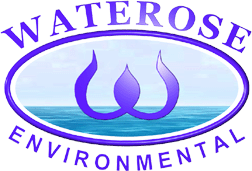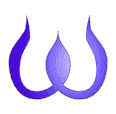 | ||||||
| Articles | Projects | Resume | Cartoons | Windsurfing | Paintings | Album |
Sooke River Twelve Month Baseline Water Quality Study for Salmonids
by Judith R. Burke

Waterose Environmental Services
Vancouver Island, BC

Section 2. Profile Continued
2.2 River Characteristics
The SRW is a community watershed with a variety of anthropogenic stakeholder interests. In addition to the human value interests, the lower SRW provides habitat to anadromous salmon and the upper SRW provides habitat to resident freshwater species.
2.2.1 General Stream Characteristics
The SRW includes the upper and lower SRW. The primary tributaries that are accessible to anadromous fish include De Mamiel Creek and Charters River. The lower SRW, which is slow and meandering with riffle and pool sequences and gravel deposits for spawning, is prime habitat for salmonids. The main tributaries are listed in Table 5, which is based on "Prioritization of Significant Watersheds Draining to Sooke Bay, Sooke Inlet, Sooke Harbour, and Sooke Basin" (Ship, 1999).
Table 5. Tributaries in the Sooke River Watershed.
|
Tributary (from the mouth) |
Drainage Area (km3) |
Stream Length (km) |
Stream Characteristics |
Fish Species Present |
|
Sooke River Lower |
40 |
8 |
Low Gradient Meandering Pool/Riffle Gravel Beds |
Coho, Chum, Chinook, Steelhead, Rainbow Trout, Cutthroat Trout, Dolly Varden char, Prickly Sculpin |
|
Alderbrook Stream |
0.5 |
1.0 |
Small Urban Stream |
Cutthroat Trout |
|
De Mamiel Creek |
40.0 |
18 |
Moderate Gradient Low Flow Pool Riffle Urbanized |
Coho, Chum, Chinook, Steelhead, Rainbow Trout, Cutthroat Trout, Smallmouth Bass, Lamprey |
|
Baker Creek |
0.9 |
0.5 |
Low Gradient Urbanized |
Salmon, Cutthroat Trout |
|
Charters River |
21.0 |
11 |
Moderate Gradient |
Coho, chum, Chinook, Steelhead, Rainbow Trout, Cutthroat Trout |
|
Sooke River Upper |
>300 |
40 |
Upper Steep Gradient |
Resident Rainbow Trout and Cutthroat Trout |
|
Total |
402.4 |
78.5 |
|
|
2.2.2 Sooke Lake Watershed
The Sooke Lake Reservoir is the largest watershed in the Greater Victoria Area. The drainage area is 7070 hectares and the catchment area is 6990 hectares (Acres, 1999). The surface area of the original lake was 372 hectares, which was increased to 436 hectares with the construction of the first dam in 1915. A second dam was constructed in 1970, which increased the surface area of the reservoir to 610 hectares with a storage capacity of 52,300,000 cubic meters. The current storage capacity will be further increased with the approval and construction of a new dam.
2.2.3 Discharge
The Sooke River is characterized as a "high energy" system that has a wide range between high and low flow periods. Historic flow information is available from five Water Survey Canada hydrometric stations located on the Sooke River system. A synopsis is contained in "Sooke Water Allocation Plan" (Jackson & Blecic, 1996). There are concerns about minimum flow requirements for fish.
Station 08HA059 is located on the Sooke River downstream from the Sooke Potholes and operated from 1989 to 1994. The average flows ranged from a minimum 0.401 m3/second in July to 23.5 m3/second in December, which are illustrated in Figure 6. The monthly averages are summarized in Table 6 (Jackson & Blecic, 1996). The Mean Annual Discharge is 9.460 m3/second.
Figure 6. Sooke River Discharge 1989 to 1994.

Table 6. Sooke River Discharge 1989 to 1994.
|
Water Survey Canada Hydrometric Station 08HA059 Sooke River Discharge m3/sec |
||||||||||||
|
Year |
Jan |
Feb |
Mar |
Apr |
May |
Jun |
July |
Aug |
Sept |
Oct |
Nov |
Dec |
|
1989 |
|
|
18 |
|
.923 |
.409 |
.432 |
.914 |
.868 |
1.92 |
|
|
|
1990 |
20.1 |
|
17.7 |
5.7 |
1.44 |
2.09 |
.296 |
.114 |
.135 |
9.66 |
|
|
|
1991 |
28.4 |
32.2 |
12.0 |
17.3 |
1.72 |
.481 |
.281 |
2.71 |
1.64 |
1.26 |
23.5 |
29.5 |
|
1992 |
39.7 |
22.8 |
3.76 |
3.52 |
2.04 |
.32 |
.309 |
.134 |
.428 |
3.11 |
16.1 |
12.5 |
|
1993 |
14.8 |
4.66 |
13.7 |
7.38 |
4.84 |
1.91 |
.644 |
.317 |
.089 |
1.4 |
5.53 |
16.7 |
Station 08HA025 was located at the mouth of De Mamiel Creek and operated from 1969 to 1974. The average flow in the summer period ranged from 0.006 m3/second in August to 0.915 m3/second in April (Jackson & Blecic, 1996) as illustrated in Table 7.
Table 7. De Mamiel Creek Discharge 1969 to 1974.
|
Water Survey Canada Hydrometric Station 08HA025 Sooke River Discharge m3/sec |
||||||||||||
|
Year |
Jan |
Feb |
Mar |
Apr |
May |
Jun |
July |
Aug |
Sept |
Oct |
Nov |
Dec |
|
1969 |
|
|
|
1.11 |
.186 |
.027 |
.005 |
.001 |
.182 |
|
|
|
|
1971 |
|
|
|
.553 |
.067 |
.014 |
.003 |
0 |
.005 |
|
|
|
|
1972 |
|
|
|
1.49 |
.17 |
.014 |
.176 |
.01 |
.099 |
|
|
|
|
1973 |
|
|
|
.507 |
.174 |
.048 |
.015 |
.007 |
.011 |
|
|
|
|
1974 |
|
|
|
|
.375 |
.256 |
.101 |
.014 |
.011 |
|
|
|
|
Mean |
|
|
|
.915 |
.194 |
.072 |
.060 |
.006 |
.062 |
|
|
|
2.3 Water Use
Licensed water withdrawals are monitored and regulated by MELP under the water license program. The primary licensee is the Capital Regional District for storage in the Sooke Lake to meet domestic drinking water needs. The types of water licences for Sooke River are summarized in Table 8 based on information to 1996 from the Sooke Water Allocation Plan by Jackson and Blecic.
Table 8. Monitored and Regulated Licenced Water Demand by Purpose.
|
Purpose |
Quantity |
Units |
Demand (dam3/year) |
|
Waterworks |
8,000,000,000 |
GY |
18184.00 |
|
Storage |
44,500 |
AF |
54,908 |
|
Irrigation |
38 |
AF |
46 |
|
Domestic |
4,500 |
GD |
4 |
The Capital Regional District is the highest consumer, with the single waterworks licence allocated to supply the domestic needs of the city of Victoria. The improvements to the Sooke Lake dam will increase holding capacity of the reservoir and likely the quantity allocated for withdrawal in the licence. The four irrigation withdrawals are primarily for small rural hobby farms with livestock. The nine domestic licences are for individual residents and average 500 GD each, representing only a minor consumption. Two licences on De Mamiel Creek have almost 450 dam3/year allocated for conservation purposes whereas there are no holders of conservation licences for the Sooke River.
2.4 Land Use
The SRW is a multi-stakeholder community watershed with a variety of uses including timber harvest, commercial and residential development, and, parks.
The northeast section of the lower SRW, at the Potholes site, is approved for the development of a major destination resort called Deertrail. The northwest section of the lower SRW is actively harvested by Timber West. The southern section of the lower SRW is a residential and agriculture.
The land use map in Figure 7 is based on the Sooke Local Area Plan, which is currently under revision.
Figure 7. Land Use Map.

Map Reference Source is the Sooke Local Area Plan.
Next Section 2.5 Wildlife and Fish
Back to Table of Contents
For more information about the Sooke River Watershed:
 Email Judith Burke at Waterose Environmental Services
Email Judith Burke at Waterose Environmental Services

Other Water Quality Projects by Waterose:
Water Quality Tests Offered by Waterose
Twelve Month Baseline Water Quality Study for Salmonids in the lower Sooke River Watershed (Victoria Times Colonist Enviro News)
Twelve Month Baseline Water Quality Study for Salmonids in the lower Sooke River Watershed (Sooke Mirror)
Water Quality Project on Musqueam Salmon Stream in Urban Vancouver
Analysis of Coliforms and Nutrients in surface waters flowing into Esquimalt Lagoon
Water Quality Monitoring on Ayum Creek, a wild salmon and trout bearing stream, for Society for the Protection of Ayum Creek and Fisheries and Oceans, Canada
Testing the Waters
Story in Sooke News Mirror, March 28, 2001 about the Automated Water Quality Monitoring Project

 email Waterose
email Waterose
Please Sign My Guestbook
Please View My Guestbook

| Articles | Projects | Resume | Cartoons | Windsurfing | Paintings | Album |
 | ||||||